Many people buy Toyotas because they are Toyotas – which have a reputation for being durable, reliable cars that are known to depreciate less fast than other cars.
But how about a Subaru with a Toyota badge?
Does the mojo transfer?
The “Toyota” 86 sport coupe is the only Toyota made by another car company – with another car company’s engine under its hood.
But a Toyota badge on its hood.
It’s functionally identical – and nearly cosmetically identical – to the Subaru BRZ.
Both are similar to the Mazda Miata – their primary rival – in terms of being affordably priced rear-drive sports cars. But the “twins” have back seats – which the Miata doesn’t – aren’t convertibles (the Miata is) are powered by low-mounted/horizontally opposed “boxer” engines (Porsches are the only other cars that have these) and have large trunks for small, purpose-built sports cars – unlike the Miata, which doesn’t have one of those, either.
As to why Toyota is selling Subarus . . .
At first, it wasn’t.
Scion – Toyota’s small car brand, sold it – as the Scion FR-S. But Toyota cancelled Scion – leaving the FR-S (which was the one “Scion” that sold well) without a place to be sold. Which is why it is now sold under the Toyota label as the 86.
But it’s still a Subaru in all but name. And price.
Which is slightly higher than the same car sold under the Subaru label.
You can buy the BRZ for $25,795 to start vs. $26,655 for the lowest-priced version of the same thing wearing a Toyota badge.
A top-trim BRZ Gray Series stickers for $30,140 – vs. $32,420 for the equivalent “Toyota” 86 TRD.
Toyota’s rep doesn’t come free.
What’s New
Not a whole lot has changed – other than the names – since the Twins made their simultaneous debut five years ago.
But this is good news – if you want to avoid some of the new driver-pre-emption tech (styled “assist”) such as Lane Keep Assist, Automated Emergency Braking and, of course, ASS – the unintentional acronym for automated stop/starting of the engine at every traffic light.
Almost very new-design new car comes standard with these “assists” – which are really nudges toward acceptance of the car being in the driver’s seat rather than you.
The 86 doesn’t even offer them as options. Huzzah!
Avoid them while you still can – because it won’t be for much longer.
You can also get a firmer-riding suspension, upgraded (Brembo) brakes a more aggressive-sounding exhaust system and high-performance summer tires on 18-inch wheels – the TRD (Toyota Racing Development) package, which is new for 2019.
Seats four. Not comfortably. But possibly.
Isn’t a convertible. Not everyone wants a soft-top.
Low-mounted “boxer” engine – just like a Porsche – without the Porsche price.
What’s Not So Good
Toyota rep adds to the price. Get the same car for less at a Subaru dealer.
Some want a soft-top.
Not as light on its feet as Miata – because it’s 500 lbs. heavier than a Miata. Really.
All 86s – like all BRZs – are powered by the same Subaru-built 2.0 liter horizontally opposed four cylinder engine, which makes 205 horsepower when paired with the standard six-speed manual transmission and 200 when paired with the optionally available six-speed automatic.
Both cars get to 60 in the same 7 seconds – with the manual. Automatic-equipped versions are noticeably less speedy. Not because of the mere 5 horsepower deficit but because of the absence of a turbocharger.
The Twins don’t have them – or offer them. Which means the engine has to be revved to make power – to get the car going. Peak horsepower occurs at a sport bike-like 7,000 RPM and the maximum (and meager) 156 ft.-lbs. of torque it produces isn’t produced until you spin the engine to 6,4000 RPM. 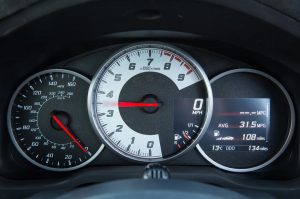
Which is easy to do . . . with a manual transmission. Just rev it up.
But with an automatic, it takes longer for the engine to build speed – and make power- which is why it takes more time for acceleration to occur. A turbo corrects for this by lowering the point at which peak torque, especially, is made. Modern turbocharged gas engines often make their peak power at very low RPM – almost like diesel engines. In many cases, below 1,500 RPM. Which means it’s not necessary to rev them to get power out of them – and so they work excellently with automatics.
Here, not so much.
Mileage with the automatic is, however, noticeably better: 24 city, 32 highway – vs. 21 city, 28 highway with the manual.
The 86 isn’t very quick, even by family sedan standards. A V6 Camry gets to 60 two seconds sooner.
This absence of quickness has been the basis of criticism from the general car press, which does not grok that different standards apply.
Quickness isn’t the measure of a sports car. How it handles – and how it sounds and feels – is.
Using those metrics, the 86 (and its Subaru-badged twin) more than deliver the goods. The boxer engine is both growly and revvy. It practically insists you hold each of the six-speed’s gears until the engine bumps up against the rev limiter; then stab the clutch, grab the next gear . . . and do it again.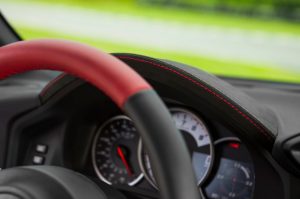
You can just drive this car. There’s torque enough for stop-and-going.
But it is a car that wants to be driven. You will want to do that, too. For the same reason you don’t order a salad and a diet Coke at a steak house.
It is also unique – a least in this price range.
The 86 and BRZ are the only rear-wheel-drive sports cars with a boxer engine that you can buy for less than $59,000 – the base price of the Porsche Boxster (which is the least expensive of Porsche’s models). You could buy a pair of His n’ Hers 86s – or one in white and another in red, for yourself – and have almost $10k left over for gas.
The boxer engine also makes the car interesting to drive.
The flat four doesn’t sound like other fours, which mostly sound the same. It has an obstreperous, thrashy-clashy sound – almost like an air-cooled flat four but without the overheating.
And there is a balance advantage to the design, because the engine sits wider in the chassis as well as lower – the weight of its cylinders split evenly across the front-to-rear centerline of the car. Two on the driver’s side, the other set on the passenger side – each boxing (hence the name) as well as counterbalancing the other.
It is a heavier-feeling car than rival Miata, which makes sense because it is. By a shocking 500 lbs – the equivalent of one fully dressed cast iron Chevy V8.
But it’s still a very fun car to drive – which is ultimately what matters.
And you drive it – which matters a great deal, to those who still care about such things.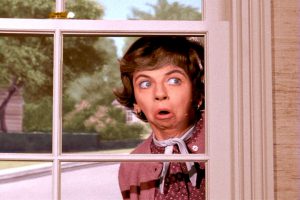
The 86 is – per above – one of the very few new cars you can still buy with plastic on the seats and zero miles on the odo that doesn’t try to “assist” you when you drive. If your tires touch a painted line on the inside corner of an apex, the steering wheel won’t vibrate – or pull in the opposite direction (Lane Keep Assist). If you thread the needle through traffic, the car will not slam on the brakes – and cut throttle – because it thinks you got too close to another car for saaaaaaaaaaaaaaaaaaaaaaaaafety (Automated Emergency Braking).
And best of all, the engine stays on until you cut it off.
You don’t have to remember to shut off the ASS every time you go for a drive to prevent the car from shutting the engine off at every traffic light.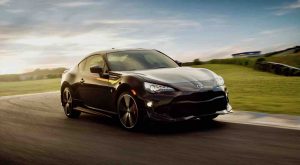
The whole thing is refreshingly retro – not in the stylistic sense but the functional sense. A set of analog gauges that expect you to mind them. A short-throw six-speed shifter. Very little else.
Nothing else, that is to say, to distract you from the business at hand.
An LCD screen is present in the center stack but it’s clearly an afterthought and more to the point, easily ignored. Because you can.
The stuff inside the LCD screen is the usual keep-’em-busy (and their minds off driving) “infotainment” stuff.
None of which is necessary when the car itself is entertaining.
We are losing this infinitely valuable aspect of getting from A to B. An escalator is transportation.
The 86 is something different.
The 86’s backseats are almost as tight as the Miata’s tiny trunk (4.9 cubic feet, for the record). But they are there – which they aren’t in the Miata. Which means you can’t carry more than one person besides yourself – which makes the Miata a much less flexible car than the 86.
The Toyota’s back seats actually have more legroom (29.9 inches) than the back seats in the much larger Chevy Camaro – which has about 24 inches. If there were more headroom, the 86’s backseats would almost be . . . comfortable. 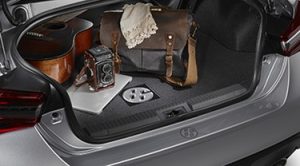
But the point is, you have them – which means you have options. Being able to carry even two passengers (vs. the Miata’s one) is the difference between needing one car and two.
You also have a startlingly roomy trunk – which can swallow amazingly large items because of the full-sized pass-through you can create by lowering the backs of the rear seats. When you do, you’ve got almost twice the space for stuff as the Miata does.
Which is no small thing.
The hardtop-only layout has its pros – and cons.
On the pro side, a hardtop doesn’t stain or tear and is much less vulnerable to thieves. It is also much less likely to leak. Even the tightest fitting/best-sealed convertible top will almost inevitably leak, eventually. The opening and closing creates fatigue points or points that just don’t fit as snugly as they once did. Seals shrink and crack. Water comes.
On the con side, you can’t lower the top on nice days – and visibility with a top that doesn’t drop is not as panoramic as it is with the top dropped.
The 86 has excellent forward visibility and even to the rear – unusual for a hardtop sports coupe – because the glass area is comparatively large. But the view to the sides isn’t great because of the taper of the roofline, the huge C pillars and the very small rear quarter glass. Look twice – at least – before you pull out into traffic from a side street.
Then, punch it!
Physically, the 86 is a bigger car than the Miata. It’s almost a foot longer overall (166.7 inches vs. 154.1 inches) but it’s still a very tight package that has a huge advantage swimming among today’s lunkers – and parking among them.
And when you do park it, you can pull up the manual parking brake. Another functionality blessing that’s becoming absent among new cars. The manual-lever brake is simpler, obviously. No electrics involved – and so no electrical parts to inevitably stop working one fine (and probably expensive) day.
But also, the pull-up brake gives you more control over the car – an important attribute in a sports car. You can use it to lock the rear wheels up while the car is moving, for instance. Not to slow the car down – but to change the car’s direction.
This is important to people who still like to drive – and know how to – and prefer a car that doesn’t prevent them from doing it.
The Rest
This “Toyota” will probably hold its value better over time – even though it’s a Subaru. Just because of the badge.
Which makes amends for this badge’s higher price tag.
Still, it is a Subaru – which means Subaru parts. And – arguably – service. No slam on Toyota service, but Toyota stores specialize in Toyotas. Here, the badge may matter – because Subaru techs are trained to work on Subaru engines and without question work on them more regularly than Toyota techs and so have more experience dealing with the unusual boxer engine and its quirks.
Speaking of working on it.
If you pop the hood you will find the oil filter – without having to look for it. It’s right there on the top of the engine (right side) and easily removed/installed by hand, without tools and without having to do more than raise the hood. This is a Subaru Thing and a commendable thing.
The rest of the engine is remarkably accessible as well. And – even more commendable – it isn’t covered by an ugly plastic shroud. You can see the engine – which is made beautiful to see by red powder coating of the intake manifold.
As we descend into Electric Car Homogeneity, we are not likely to see much of this sort thing again.
Seize the day – before it’s gone.
The Bottom Line
If you like the idea of a Subaru sports car – with a Toyota rep – the 86 ticks both boxes.
Regardless of the badge.
…
Got a question about cars – or anything else? Click on the “ask Eric” link and send ’em in!
If you like what you’ve found here please consider supporting EPautos.
We depend on you to keep the wheels turning!
Our donate button is here.
If you prefer not to use PayPal, our mailing address is:
EPautos
721 Hummingbird Lane SE
Copper Hill, VA 24079
PS: Get an EPautos magnet (pictured below) in return for a $20 or more one-time donation or a $10 or more monthly recurring donation. (Please be sure to tell us you want a sticker – and also, provide an address, so we know where to mail the thing!)
My latest eBook is also available for your favorite price – free! Click here. 


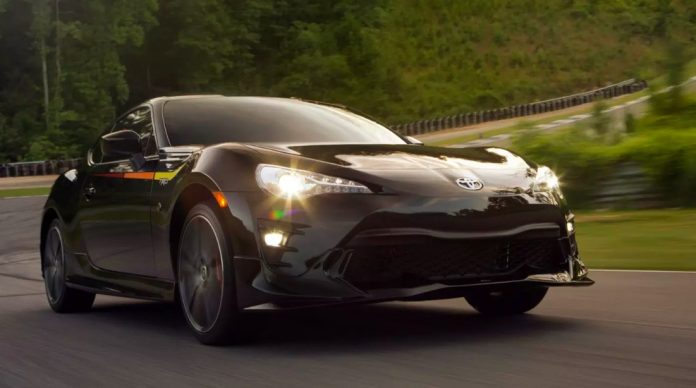

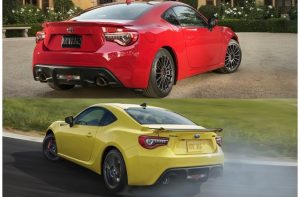
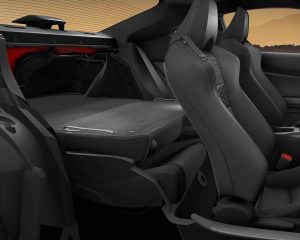
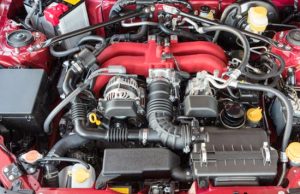
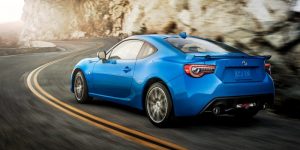
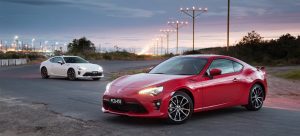








Toyota has been re-badging Mazda 2 hatchbacks as Yaris hatchbacks for a few years now.
Another disguised car is coming to join the 86. The next Toyota Supra will mostly be a BMW.
I went to the local Toyota dealer to see about a test drive in an FRS, but as soon as I got into it, I could see it wasn’t for me. There was no head room, and I’m only a tad over 6″1″. I really like them, but there’s just no way I can fit into them. I see a lot of kids driving around in them, but I suspect they will probably grow out of them in a few years as well.
This is nothing new. Japanese automakers have been building each others cars for as long as there have been Japanese automakers. The same thing is true of the big three, trim being the only major difference between many Fords and Lincolns, Chevrolets and Cadillacs, and Chryslers and Dodges. Dodge would never have been replaced by Ram if Americans hadn’t developed a taste for blustery pickups. Nissan is tapping into that trend.
Automobiles have become so commoditized that it is almost impossible for the average non-car nut to tell the brands apart without a brand badge.
I have two Subarus a 95 Legacy wagon: 2.2L 5spd and 05 Outback 2.5L automatic. The 95 has been an absolute pleasure to own and maintain. The 2.2L is very robust engine. They came in the Legacies (Brighton model)until 99, and in the Impreza model until (I think ’02). I would have no hesitation buying one of these cars, even today. The exhaust note from the 2.2L is sweet. (The 2.5, not so much). The boxer engines of both types, but especially the 2.2, is a pleasure to work on. You can get at everything. I have not had any major engine problems with it, and have 278k on the clock.
The ’05 is a different story, but still an okay experience. Yes, I had to replace the head gaskets. When I first inspected the car for purchase, there was a small oil leak right at the oil filter. I thought it was just the filter. However, the head gasket is in the immediate area, and turned out that was it.
The Subaru head gaskets fail in the following sequence: 1) An external oil leak, which was the case for my car. This is the first stage. 2) Second is an internal oil leak, whereby the oil is also getting burned. 3) Third stage is external coolant leak, and 4) Last stage is internal coolant leak. My repair cost was $2500 about 2yrs and 30+k ago. So far, no problems.
I think they finnnalllllyyy got the damn head gasket stuff straightened out when they went to the timing chain in the 2.5L’s. I think this is around ’11 for the Foresters and ’13 for the Outbacks. First gen CVT’s in Outbacks are junk, but the 2nd gen (2015) works okay from what the Internet tells me.
That Toyota/Subaru sounds like a fun car to drive, but I’m pretty sure I (myself) am addicted to the 400+HP offered in the current Mustang GT.
We had a ~95 AWD Legacy wagon for our daughters to drive to HS, and it was a disaster for the purpose. Rear axles destroyed from driving on muddy road (that’s how they got to school). Engine light came on the day after we brought it home. We paid dealer $150 just to read the damn codes, and the cats were bad and not covered by the service plan we bought with the car. They wanted over $1000 to fix but we got a local shop to chop and put in a generic cat for ~$200. Then the brakes started acting up, and I found out that the vacuum hose cost $40 because the check valve was built in, versus maybe $5 for 16″ or so of bulk hose. The shop that we special ordered the hose from was sort of pissed that I said I could deal with two spring clamps and didn’t need to pay another maybe $50 for labor.
In fairness to Soobie, I think the dealer was a Crook and I suppose if you just drive on pavement and a little snow that you would be okay.
And my mom had a 2004 Forester that had the head gasket problem at only 70K miles. Sorry, but I have no use for the damn things.
It’s nice to know that I’m not alone, Tom. My ’06 WRX is well into stage 4.
Another huge advantage over the miata is that the 86 comes standard with a limited slip diff vs the miata you have to upgrade to the club trim.
Hi Mooeing,
I should have mentioned this; thanks for doing so! A sports car without a limited slip rear is like a runner with one leg.
Are they putting the limited slip function through the traction control system by using the brakes?
I’m pretty sure it’s a real LSD
I meant for the open diff
I saw one of these recently. Not close enough to know what it was but a really nice looking car, better than anything I’ve seen in a while. Had I known what it was I would immediately began to think what could be done with it. For cheap and really huge amount of power, I’d do the LS/Tremec thing to one and blow everyone into the weeds. It’s easy to build a 800 hp LS and not costly. Spend more on the parts to keep the car together most likely. I’d bet it would need a wee larger wheel/tire and brakes. With the looks and the badges, it could be worth a lot of laughs showing a ZR1 your ass….unless of course, it was a 1,000 hp ZR1 but it would amaze the driver of the ZR1.
This is the thing that really pisses me off about GM and what they’ve done. From the 50’s they ‘ve had the best engine/transmission combos…..even though at times you’d need to jerk the original engine out and work it over.
Back in the late 70’s a friend bought a crewcab 454 pickup to pull a trailer and went to Ca. to get a vehicle. He was so disgusted with the 454, when he got back, he pulled it out, emptied a .44 mag into it and then built a “real” engine for it as he termed it. Of course the “real” engine only had about 3 times the power. He owned a hot rod shop and could react violently to shitty powered cars or trucks, esp. one’s that should have been tire rippers. He had a 56 Chevy wagon you didn’t want to race and used it to haul the crew to lunch as stuff. Lubbock is the worst town of drivers that run reds. Don’t know what it is but let it ice and snow and they all drive faster, well, briefly. He got t-boned that destroyed it. He was quite ready to kill and the only person I knew who had a full-out Thompson behind the desk.
“The “Toyota” 86 sport coupe is the only Toyota made by another car company – with another car company’s engine under its hood.”
Eric, I beg to differ. Isn’t the new Supra basically a BMW, with different cosmetics, and minor differences in engine and suspension tuning?
Obviously, the market emphasis is on SUV/CUVs. But Toyota has more than enough discretionary funds to build another Halo Sports Car that could become a legend, like the MR2, or previous generation Supra. Instead of subcontracting to Suburu, Toyota should have set out to build a sports car that would blow the Miata into the weeds! They could have, if they still had enough fire in their corporate soul.
Taken out of context, this Subie, and the new Supra are decent to very good Sports Cars. But as sad symbols that Toyota is now too lazy to build its own, they really are ” A Bad Thing.”
It’s not that, it’s because they’re well aware of Agenda 21/UN 2030/whatever ya wanna call it, is on its way and it’s cheaper to codevelop and comply than to DIY
What a damn shame though, I so agree with you 1000%
The Supra does have one big problem that you missed.
A particulate filter, even in the US market, even though they aren’t mandatory yet. But as far as I know, it will be eternally illegal to get rid of it anyway, just because it came with one. There’s about 50 horsepower right there that the car will always be missing because “lol, too bad!”
I’m gonna ask the seemingly obvious question – since this car is waay slower than a V6 Camry, does it handle significantly better than said Camry? Does it corner faster or handle bumps in the road better?
Cause a car looking and sounding fun doesn’t, in my mind, compensate for being outperformed by a family sedan with lots more room.
Remember the sludge wars when the Toyota engines slugged up and blew up and the company refused to back their products up? Remember the thousands and thousands of Toyota trucks that suffered along with their owners when the frames rusted away before the second oil change? Huge recall ignored by Consumer Magazine. Oh, and don’t forget about the sticking gas pedals. They said it was the floor mats. The family that was killed when their fancy Lexus flew off a cliff, full throttle out of control. Why don’t you talk about these Toyotas Eric in one of your informative articles?
Hi Patriot,
Brand loyalty is a weird thing; it’s not unlike people’s loyalty to a football team. Sometimes, it’s because the team is good. Sometimes, it’s just because. Toyotas are generally/historically better-than-average cars in terms of reliability and that helps account for their lower-than-most depreciation (which is also a function of general popularity, which is related to the reputation for being good vehicles).
A lot also depends on the particular car in a given brand’s lineup – and the engine (and sometimes, the transmission).
You’re absolutely right about CR; their biases are as obvious as Bruce Jenner’s sex.
Hi Jim,
Yes, absolutely; especially once running hot! The FWD Camry handles well during reasonable driving. Amp it up, though, and the nose-heavy understeering characteristics manifest – as is typical of FWD cars. The rear-drive 86 is more neutral, better-balanced and you can throttle drive it in away that you can’t a FWD car.
If you were to take this car and a V6 Camry each out for a round trip test drive in the mountainous roads near you, at around 3 am when the roads are clear, pushing them as hard as you can, which would get home first? Would the power of the V6 make up for the time lost in the corners?
Curious how that comparison would turn out.
Hi Jim,
The trip would be much more fun in the 86! And if the driver of it knew his bidness, he’d get there first, too!
Taking a test drive in the mountainous roads at 3AM, the roads would only LOOK clear right up until you ran over a you-know-who. I myself used to believe you could escape the nonmotorized plague by going out late at night but a barrage of late-night hitchhikers killed that belief and a guy biking lightless at 2AM (probably DUI revocation) glued its coffin shut.
Unless you’re pushing as hard as you can but still apexing on some imaginary line about 4 feet to the left of the shoulder line, to which I say completely heck that noise.
This smells of entrapment to me.
Do you really want to drive an automatic Camry over one of these with Manual?
I’m sure for the price difference between the two, you can add Headers, better tires, a drop in filter and possibly a tune, thus increasing the power to weight to narrow the gap, and making a fun car even more fun.
The car was built and developed to be fun, and we both know it shines in corners and backroad’s, though again, adding more power combined with it’s light weight will narrow the gap
I’m not a fan of two lane blacktops. So easy for something really bad to happen. But if thats what you got thats what you got.
Where is that secondary air hose offshooting from the main air intake hose going to?
OT:
Cops deploy snipers dressed in camo against Moms protesting drag queens reading to pre-schoolers
https://dailycaller.com/2019/06/22/mom-protest-drag-queen-story-hour-sniper/
Over her dead body. That sounds good. They wouldn’t get within a mile of a child of mine…..and I have no religion. I just don’t want a big man with a big erection under a dress read some perverse story to children. I bet she could whip my ass with her little finger. Probably send me reeling by lifter her skirt with no undies.
I’ve not been back in a Target since their bathroom obscenity.
What we are witnessing is the now 70 year old Frankfurt School Marxism plan for destruction of Western, initially German then US civilization.
Polymorpheus Perversion.
William Lind is good on this,
https://www.theamericanconservative.com/2009/11/19/the-roots-of-political-correctness/
As a Subaru owner (not a BRZ), if you want one consider these two pieces of advice:
First, lease, don’t buy. Subarus, at least the two I have personal experience with, haven’t aged well-and one of those is my daughter’s 2017. I know two other people who have had Subies who would second this thought. They aren’t what they were back in the 70s-80s.
Second, do not get an automatic. It’s a Jatco CVT, and it’s weak. You don’t want to know what it costs if you have to work on one.
First points probably valid, but the Toyobaru there is Automatic automatic, think from a IS-F gearbox minus two cogs
Still, with a car like this, sure the aftermarket has a solution to any problem
I was going to ask if anyone knew if these Subarus still had the oil burning problems and head gasket failures. I keep hearing that the “new” ones don’t have those problems anymore. Have been hearing that for the past 10 years or so. Shame because I like a lot about what Subaru does, but oh well.
Also, do you think Jatco conventional automatics are better? I tend to blame the CVT as a technology less than the manufacturer making them.
Well, we had a 1999 Subaru Legacy Wagon with 2.2L Flat-4 and Jatco 4 speed auto and AWD. ~140K miles, no head gasket troubles, no oil burning, no transmission troubles. Had a spin-on trans oil filter, trans dipstick, AND a front differential dipstick! Loved it, until it got rear-ended by a 17 year old idiot and totaled. Also had an 04 VW Golf TDI with a Jatco 5 speed auto. Previous owner had the trans overhauled at ~150Kmi (all highway), we had to have it redone at ~ 240Kmi. Jatco non-CVT autos are a mixed bag in my experience, but not as problematic as Jatco CVT’s, re: Nissan Versa/Altima recalls and extended warranties. Doing good to get to 100Kmi with their CVTs.
Even Aisin AW autos are not as reliable as one would hope, witness the VW 6-speed Tiptronic made by AW. Soft valve bodies, not unusual to require an overhaul ~120Kmi.
Ah, for the days of a 150 Kmi Torqueflite!
My experience with Subarubuarubas from the 70’s and 80’s had them solidly in the DON”T BUY ONE DON”T DRIVE ONE DON”T OWN ONE category.
The earlier pushrod boxer fours were absolute junk. My Dad wore two of them out in no time.. he who nursed an ancient decrepit Austin A 35 through a three hour daily commute on Los Angeles freeways for years. The later boxer six was a disaster, friend of mine with a local import shop had one in one time I dropped by for a visit. He was on the phone with the owner. Seems it had blown head gaskets. Engine out, redo heads, new cam belt… close to $6K. Car had 110 K on the clock. After he got off the phone, he smiled real big.. we LOVE these boxer six Subies. NO ONE ever nurses one past the 125 K mark without blowing the head gasket. I aksed him whether the engine was interference or not. He said interference. OK, how often do the cam belts fail, splattering that engine? He said NEVER. WHATTTTT!!!! SImple reason: since the head gaskets ALWAYS blow by about 120K, no one ever has the belt break, because replacing that is always part of the head reseal.
Hmm. shades of the old air cooled VW boxer fours….. valves need redone about every 40 to 50 K, bottom end done every other head rebuild. I LOVED those old air cooled VeeWees, I made a LOT of money off them because they broke so reliably. Same reason Peter loved the boxer six Subies.
I’m almost certain the 6-cylinder Subaru mills have chain-driven camshafts. The chains vs. belts make for a shorter engine – easier to cram beneath the hood.
https://www.ft86club.com/forums/showthread.php?t=11587
I don’t see gasket issues on the list there, and they say ’13s were the sole problematic year of the models, though more research is required
I remember test driving it when it was a Scion years ago, since none of my friends know stick and I do 🙂
FUN little car, I mean, between her and I, 330-40lbs between us then and yet it was a little toy, loved wringing it out, still remember it (Plus the dealership is the type that since they know where you live, they don’t bother to go with you)
Curious though, you had more seat time in the 370z and the Twins, which do you prefer Eric, as I’m feeling Japanese
+1 for no engine lingerie!
Amen, RK!
People – some people – bitch about this car not having a turbo. I like that it doesn’t. One less thing to break. And I’m betting one could squeeze another 20-30 hp out of the 2.0 engine with some remapping and perhaps a better exhaust system.
But it’s not necessary. The thing is plenty fun to drive as it is… if you like to drive!
Don’t forget an improved intake, either. K&N has LOTS of nice intake systems… 🙂
You’d get more out of headers and tune, plus a drop in filters and other parts I’m forgetting.
http://www.ft86speedfactory.com/, your one stop shop for all 86 parts
I love driving small “underpowered” cars through the twistys. Many times I’d be running through the gears, constantly running through the apexes and generally working my butt off to get down the road. Inevitably I would come across another vehicle, maybe not even going much slower, and they’d almost always look bored with the drive. I know I could easily do the same, just put it all in full-auto and be done with it, but why?
Doesn’t the Subaru WRX come stock with a 2.0 four and a turbo? If so, seems like the ability to add turbo would be already engineered into the engine by the manufacturer’s other design. That is much more favorable, IMHO, than a pure-aftermarket *design* and implementation.
Hi Tom,
It does – and adding a turbo to the 86/BRZ is probably a bolt-in operation. I myself would not do this, though. The car has proportionate power and is a lot of fun to drive as it is. Drive one and see for yourself!
If you were interested in forced induction…
https://www.ft86club.com/forums/showthread.php?t=56783
Also, engine swaps:
https://www.ft86club.com/forums/showthread.php?t=94640